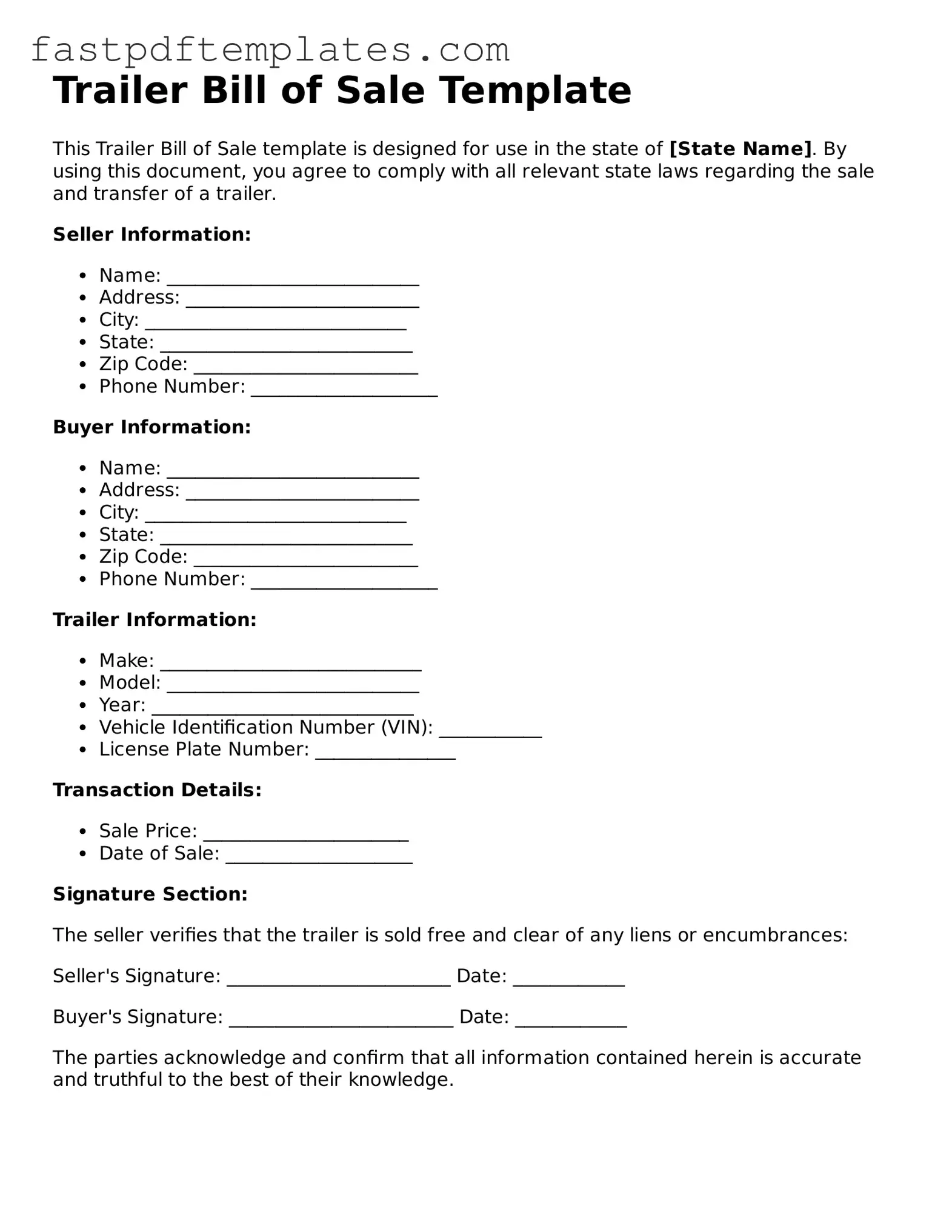The Trailer Bill of Sale form shares similarities with the Vehicle Bill of Sale. Both documents serve as legal proof of transfer of ownership between a seller and a buyer. They outline the details of the transaction, including the vehicle's make, model, year, and identification numbers. Just like the Trailer Bill of Sale, the Vehicle Bill of Sale may also include information about the purchase price and any warranties or representations made by the seller. Both forms protect the interests of both parties involved in the sale, providing a clear record of the transaction.
Another document that resembles the Trailer Bill of Sale is the Boat Bill of Sale. Similar to the trailer transaction, a Boat Bill of Sale is used to transfer ownership of a watercraft. It captures essential details such as the boat’s make, model, hull identification number, and sale price. Both forms also serve as a safeguard against future disputes, ensuring that the buyer has proof of ownership and the seller has a record of the sale. In essence, both documents facilitate a smooth transition of ownership for recreational vehicles.
The Motorcycle Bill of Sale is yet another document that parallels the Trailer Bill of Sale. This form is specifically designed for the sale of motorcycles, detailing the specifics of the bike, including its VIN, make, model, and year. Just like the Trailer Bill of Sale, it includes the names and addresses of both the buyer and seller, along with the sale price. This document helps to confirm the transfer of ownership and can be crucial for registration purposes with the Department of Motor Vehicles.
Similar to the Trailer Bill of Sale, the RV Bill of Sale is used for the sale of recreational vehicles. This document outlines the specifics of the RV, such as the make, model, year, and VIN. It also includes the sale price and the names of both parties. Like the Trailer Bill of Sale, the RV Bill of Sale serves as a legal record of the transaction, providing protection for both the buyer and seller. It ensures that the new owner can register the RV without complications.
The Snowmobile Bill of Sale also mirrors the Trailer Bill of Sale in its purpose and structure. This document is tailored for the sale of snowmobiles and includes pertinent details such as the make, model, and VIN. Both forms provide a clear outline of the transaction, including the sale price and the identities of the buyer and seller. The Snowmobile Bill of Sale serves to confirm the transfer of ownership, making it easier for the new owner to register their snowmobile with the appropriate authorities.
The ATV Bill of Sale is another document that shares characteristics with the Trailer Bill of Sale. Designed for all-terrain vehicles, this form captures essential information such as the ATV's make, model, and VIN. Like the Trailer Bill of Sale, it includes the sale price and the contact details of both the buyer and seller. This document not only facilitates the transfer of ownership but also provides a record that can be referenced in case of future disputes.
The Equipment Bill of Sale is similar to the Trailer Bill of Sale in that it is used to document the sale of heavy machinery or equipment. This form includes details about the equipment, such as its make, model, and serial number. It also outlines the sale price and identifies both parties involved in the transaction. Just as with the Trailer Bill of Sale, the Equipment Bill of Sale serves as a legal record that protects both the buyer and seller, ensuring a smooth transfer of ownership.
Finally, the General Bill of Sale encompasses a broader range of transactions, making it another document akin to the Trailer Bill of Sale. This form can be used for various types of personal property sales, including vehicles, equipment, and other items. It includes details such as the item description, sale price, and the names of the buyer and seller. Like the Trailer Bill of Sale, the General Bill of Sale acts as a record of the transaction, providing assurance to both parties involved in the sale.
